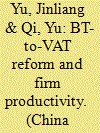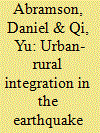|
|
|
Sort Order |
|
|
|
Items / Page
|
|
|
|
|
|
|
| Srl | Item |
| 1 |
ID:
187810


|
|
|
|
|
| Summary/Abstract |
China recently initiated a major tax reform to convert business tax to value-added tax (BT-to-VAT reform), which opened up the tax deduction chain between industries. We used difference-in-differences model and an administrative firm-level dataset from 2011 to 2017 to explore the effect of BT-to-VAT reform on productivity. We found that in contrast to control firms, this reform increased the productivity of the treated firms by 14.6% on average. The positive effects tended to be strengthened in private, large-scale, and capital-intensive firms, as well as in firms with tight financing constraints. Moreover, these positive results of the BT-to-VAT reform appeared to be driven by its positive effect on fixed asset investment, R&D expenditure, and specialization. These findings demonstrate the transformation of tax system has multiple economic effects in developing countries.
|
|
|
|
|
|
|
|
|
|
|
|
|
|
|
|
| 2 |
ID:
106752


|
|
|
|
|
| Publication |
2011.
|
| Summary/Abstract |
One of the more recent movements in China's policy for periurban planning and development is the pursuit of "town and country integration" (cheng xiang yi ti hua). The officially reframed approach to planning suggests possibilities for the official reconsideration of developmental practice, but entrenched conditions of governance, land, environmental and developmental policy, and the planning profession itself constrain these possibilities. Perhaps no other context in China illustrates these constraints more dramatically than the reconstruction effort underway in Sichuan following the earthquake of May 12, 2008. Cultural, environmental and economic differences among settlements in the earthquake zone vary widely, and local and national leaders frequently mention the opportunity the recovery presents for innovative and sustainable development, but the "cataclysmic" nature of reconstruction investment, and the extremely rapid and construction-dominated approach to recovery has prevented planners from considering local conditions or alternative approaches. If the official earthquake response has served to propel urbanization along preexisting trajectories, local geographical, historical and cultural conditions nevertheless assert themselves, even if informally. The uniquely dense, dispersed and agriculturally productive Chengdu Plain has already shaped a national discourse on urban-rural relations. The expansion of Chengdu's urban region into the narrow valleys and minority ethnic settlements across the Longmen Mountains presents new and unpredictable challenges for considering how city and country are related.
|
|
|
|
|
|
|
|
|
|
|
|
|
|
|
|
|
|
|
|
|